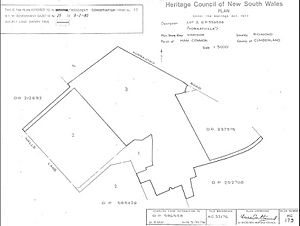Hobartville facts for kids
Quick facts for kids Hobartville |
|
|---|---|

Heritage boundaries
|
|
| Location | Kurrajong Road, Richmond, City of Hawkesbury, New South Wales, Australia |
| Owner | Hobartville Stud Pty Ltd |
| Official name: Hobartville, including outbuildings | |
| Type | state heritage (landscape) |
| Designated | 2 April 1999 |
| Reference no. | 35 |
| Type | Homestead Complex |
| Category | Farming and Grazing |
| Lua error in Module:Location_map at line 420: attempt to index field 'wikibase' (a nil value). | |
Hobartville is a very old farm and house located on Kurrajong Road in Richmond, Australia. It is a special place because it is listed on the New South Wales State Heritage Register. This means it is protected for its historical importance.
Contents
A Look Back in Time
Hobartville started as a large farm. By the 1930s, it was known as the best place in Australia for breeding Hereford cattle.
How Hobartville Began
The land for Hobartville was first given to two early settlers. James Blackman received 41 hectares in 1802. Edward Luttrell received 162 hectares in 1804. Luttrell's land was called Hobartville by 1816. It already had a house, a garden, and other buildings.
In 1816, Lieutenant William Cox Jr. bought Luttrell's land. William Cox Jr. was the son of William Cox, who built the first road over the Blue Mountains. By 1818, William Cox Jr. also bought Blackman's land. The main house you see today was finished in 1828. Cox planted a long line of oak trees leading to the house. He also planted other trees along the river.
Changes Over the Years
When William Cox Jr. passed away in 1850, his wife Elizabeth inherited the property. After she passed, their son William took over. In 1863, the farm went to their third son, Sloper Cox. He lived there until 1877.
Hobartville then became famous for breeding fast racehorses, known as "thoroughbreds." This happened after Andrew Town bought the property. In 1889, William Long and George Hill owned it. They sold it to Percy Reynolds in 1900. Reynolds continued the tradition of breeding racehorses. He owned Hobartville into the early 1930s.
The Changing Landscape
Pictures from 1931 show that some of the original oak trees had been lost. However, other trees around the house were still very strong. The trees along the entry path were fully grown. The fields near the house also had many trees.
By 1947, even more of the oak trees were gone. New trees, called plane trees, were planted along the road leading to the property. The Reynolds family sold Hobartville in 1958. By the mid-1970s, Mrs. Bruce Lindsay owned it.
Today, new houses have been built between the main house and Castlereagh Road. A road now cuts through the old entry path. Even though the old line of oak trees is still there, it is not part of the original protected area. You can still get a clear view of the Hobartville mansion from Kurrajong Road.
What Hobartville Looks Like
Hobartville is a beautiful two-story house made of sandstock brick. This is a type of brick made by hand. William M. Cox junior built it. Some people think Francis Greenway, a famous architect, might have designed it.
Key Features of the House
The front entrance has a grand sandstone porch, called a portico. It has strong, simple columns called Doric columns. Around the main door, there are tall, narrow windows called sidelights. Above the door, there is a curved window called an elliptical fanlight.
Inside, there is a curved stone staircase that seems to float without support. This is called a cantilevered stair. The house also has tall windows that open like doors, known as French windows. These open onto a porch, or verandah, with stone tiles. The roof is gently sloped and covered with slate tiles.
Hobartville also has several other old and important buildings and small houses on the property.
Why Hobartville is Special
Hobartville is very important to Australia's history. It is a complete old farm complex from the early settlement times. It is connected to the famous Cox family and possibly to the architect Francis Greenway. The original boundaries of the land helped decide how the town of Richmond was planned in 1810. It also has historical and physical links to St Peter's Anglican Church nearby.
Hobartville was officially added to the New South Wales State Heritage Register on 2 April 1999.

